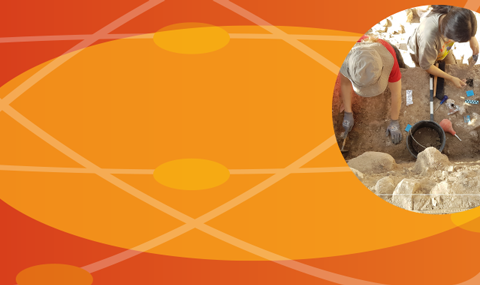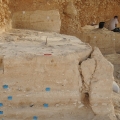The migration of modern humans
The project involves the dating of the first arrival of modern humans out of Africa. This momentous event in human history occurred at the very end of the practical range for radiocarbon dating and has proved to be extremely difficult to date. In a study of charcoal fragments from sediments from the Kebara Cave (published in the Journal of Archaeological Science), just south of Haifa on the Carmel Mountain, the scientists have shown that modern humans reached this part of the world approximately 48,000 years ago. In fact, some of the dates obtained precede the arrival of modern humans, to just beyond 50,000 years – probably the oldest absolute radiocarbon dates ever obtained.
Understanding the first villagers
The human transition, from hunter-gatherers to a more sedentary mode of life in small villages, first occurred in the region that today is covered by northern Israel, northern Jordan, southern Lebanon, and Syria. This so-called Natufian culture lasted for about 3500 years, from around 14,000 years BC to about 11,500 years BC. This long period of time is divided into the Early Natufian and the Late Natufian, based on the shapes of some of the stone tools that this culture produced.
In a collaborative study with Omry Barzilai from the Israel Antiquities Authority, which began during his postdoctoral fellowship in our lab, several Natufian sites in northern Israel were dated. This was achieved through careful field studies, as charcoal – for some unknown reason – is not well preserved in Natufian sites. The radiocarbon dating of the layers in these sites unexpectedly showed that the layers that were ascribed to the Early or Late Natufian periods actually overlap in time by a thousand years. This surprising observation will require a re-evaluation of the chronology and the cultural relation between human groups of this very important period.
The results of this study were published in Antiquity.
Chronology of the Early Bronze Age: new analysis for a high chronology
The chronology of the Early Bronze Age (EBA) in the southern Levant and the synchronization between the sites, taking into account both changes in material culture (seriation) and radiocarbon dates, show significant inconsistencies and disagreements. To resolve this problem over the whole region, we assembled 420 radiocarbon dates. The dates have been re-evaluated based on their archaeological contexts and using analytical criteria. Bayesian theory was applied to model the selected dates in relation to the given seriation of the EBA sub-periods (EB I, II III, IV). Sites with two or more sequential sub-phases were individually modeled in order to define the transitions between the sub-periods. The new chronology, published in Radiocarbon, indicates that the EB I-II transition occurred site-dependently between 3200-2900 BC, the EB II-III ca. 2900 BC, and the EB III-IV ca. 2500 BC.
The 14C dates and modeling demonstrate that the traditional dating of the divisions of the south Levantine Early Bronze Age should be revised. Taking into account that transitions from one EB sub-period to another did not necessarily occur simultaneously at all sites, the transitions between sub-periods should be considered as ranges, within which cultural changes interpreted as “transitions” occurred. This would question the synchronization between sites. A most significant outcome of this study is that a date around 2500 BC seems to be firmly based for the EB III end, which is at least 200 years earlier than the traditionally accepted dates. This will require a re-evaluation of the cause for the end of this period of city-states, which has often been ascribed to a major climate change that took place around 2300-2200 BC. It also ignited a separate project, focusing solely on the EB IV (Intermediate Bronze) period.
Several site-specific papers were published in the framework of this project on the EB chronologies of Tel Yarmuth, Tel Megiddo, Tel es-Safi/Gath, Tel Arad, and Tel Bet Yerah.
An absolute chronology for the Intermediate Bronze culture
The Intermediate Bronze Age (IBA) in the second half of the third millennium BC is an enigmatic period in the history of the southern Levant. The IBA distinct material culture was identified early in the 20th century. Hundreds of IBA sites were found since then in the southern Levant, and many of them were excavated by archaeologists. But there is still no consensus regarding fundamental details of this period: IBA timeframe; the origin of IBA population; its relation to the preceding and following periods; and are there any internal developments, or chronological subdivisions within the IBA period. These are part of the open questions still debated to date. Some radiocarbon-based dates of samples obtained from IBA related phases of various sites do exist, but until now they did not provide a solid ground that is required in order to reach firm conclusions regarding the IBA timeframe. Recent studies set the end of the Early-Bronze urban culture at around 2500 BC, while the dawn of Middle-Bronze cities and related culture is considered by most scholars to be 2000/1950 BC. This gap between the end of the EB to the MB dawn sets a possible timeframe of around 500 years for the IBA culture to exist, as opposed to a previous consensus of 200 – 300 years, and so it draws much new attention on this intriguing period in the southern Levant. The research aim is to resolve IBA timeframe and other open questions utilizing exact science tools and methods. Radiocarbon dating will be a major tool used in this research, combined with other microarchaeological tools and methods. The main objective is to compose an absolute timeframe for the IBA culture in the southern Levant by systematic dating and analysis of radiocarbon dates from various IBA sites and to identify possible chronological and typological stages within the IBA.
Dating the Late Bronze to Iron Age transition and periods
The date of the Late Bronze (LB) to Iron Age (IA) transition in the southern Levant is the key for understanding the chronology of the entire eastern Mediterranean at the end of the second millennium BCE. The importance of the transition relates to the major change in political order over the entire eastern Mediterranean that occurred at that time. At the end of the Late Bronze Age, dominating political entities such as the Hittite and Egyptian Empires disappeared from the historical and archaeological records, and small political entities such as migrants known as “The Sea People”, appear. Within the southern Levant coastal region, these settlements are recognized mainly from the abundance of locally produced Mycenaean (Myc) IIIC and Bichrome pottery.
This important cultural change took place during a period in which the amount of radiocarbon in the atmosphere increased at a similar rate that the radiocarbon isotope decays (creating a so-called plateau in the calibration curve). Thus it is a real challenge to date this transition with reasonably high resolution. We applied a detailed microarchaeological approach to the sites of Tel Megiddo and Qubur el Walaydah, which have deposits that span this transition. At Tel Megiddo, the study spreads further into the Iron Age period, throughout several of the site's excavated areas. Both studies were published in the journal Radiocarbon (Tel Megiddo, Qubur el Walaydah).
Radiocarbon for historical chronology: the Byzantine - Islamic transition in the Negev
This research aims at building the radiocarbon chronology framework for the Negev region from Byzantine to Early Islamic period and looking for evidence of environmental crisis during this period of time. Micro-archaeological approaches will be applied in sampling strategy, and various characterization methods will be utilized to evaluate preservations and diagenetic processes the samples might have gone through. The application of tree-ring calibrations with Bayesian modeling will further narrow down the calendar age distributions for serial of samples with stratigraphic relationships. Apart from conventional dating substances such as charcoal and seeds, others preserved materials such as plasters, wood ashes, and phytoliths will also be processed. The results will contribute to the establishment of a valid archaeological and palaeoclimatic chronology for the Byzantine-Islamic transition in the Negev.
Setting the Clock in the City of David: Establishing a Radiocarbon Chronology for Jerusalem's Archaeology in Proto-historical and Historical Times
The relatively detailed historical record of Jerusalem and the importance of Jerusalem throughout history makes Jerusalem a key site for the history and archaeology of the Near East.
This study aims at producing an absolute 14C based chronology for the archaeological strata of ancient Jerusalem, thus enabling a better link between archaeology and known historical events and processes. An absolute chronology for Jerusalem is also important for understanding the larger regional development of the southern Levant.
Prior to the current study, there were surprisingly less than ten published radiocarbon dates from Jerusalem, despite the 150 years of archaeological excavation. The project aims at correcting this, by applying extensive stratigraphical and well-controlled radiocarbon dating to the ongoing excavations, as well as re-exposing strata from past excavations from remaining sections and borders of the excavations. A case study on the Gihon Spring Tower has already shown that the Middle Bronze Age date, given formerly to the tower, needs to be re-evaluated (published in the journal Radiocarbon). A study made below Wilson's Arch found that the first phase of the arch was built by Herod the Great. Several decades later, the arch was expanded by one of the Romans' procurators, before the Great Revolt at 70 AD. A small theatre was exposed in the excavations (shown in the picture above). We found that it was built in the time of Hadrian, just before the Bar-Kochva Revolt at 132-136 AD. Several additional structures and features were dated as well. This study was published in the journal PloS ONE.
An emphasis on the Middle Bronze Age was given in several locations. The 44 dates, sampled with microarchaeology methods from three different locations along the eastern slopes of the city’s ancient core, reveal that Jerusalem was initially settled in the early phases of the period, with public architecture first appearing at the beginning of the 19th century BC and continued to develop until the 17th century BC. At that time, a curious gap in settlement is noted until the 16th century BC, when the site is resettled. The construction of this phase continued into the early 15th century BC. This work was published with open access in the journal Radiocarbon.
This project is supported by an ISF grant, received by Elisabetta Boaretto (WIS), Yuval Gadot (TAU), Joe Uziel (IAA), and Doron Ben-Ami (IAA) in order to establish a radiocarbon anchored chronology in Jerusalem. The field sampling and context analyses are conducted by Johanna Regev (WIS). The research team identifies key archaeological contexts for dating and conducts careful on-site sampling for dateable material. The dated contexts are characterized by microarchaeological analyses, and the stratigraphy and ceramic assemblages are evaluated. After the radiocarbon measurements, chronological models are built with Bayesian modeling based on stratigraphy. Archaeological strata, structures, and monuments of importance from previous excavation will be sampled in the field where possible, and these will be connected to the chronological radiocarbon backbone of Jerusalem.









